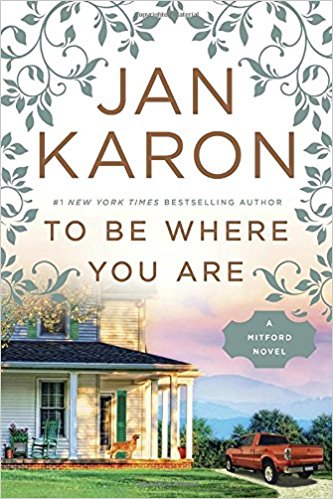To Be Where You Are - A Review
I’ve wrestled for years with my thoroughgoing enjoyment of Jan Karon’s stories about Mitford, NC and the hijinks of the population of that mythical town. After all, I’ve got an undergraduate degree in English literature and now a Ph.D. Certainly I should prefer cutting edge masterpieces that might someday find their way into the literary canon and are laced with esoteric symbolism. It might be alright if I dip my toes into the mystery stories of someone like Dorothy L. Sayers, who has the academic respectability of an MA from Oxford, but it can’t be ok to enjoy light fiction like Karon’s. Can it?
I’ve decided there is good reason for all of us to like Karon’s stories, even if they don’t rise to the level of literary sophistication of a postmodern novel. (And, perhaps that is another solid reason for us to enjoy them with integrity.) Karon’s stories tell a beautiful story well, reveal something of what it is to be human, and leave us longing for a better world. She has created a world that struggles with the same sullied circumstances that surround our reality, but she weaves in an ever-present theme of hope. Karon shows us what life with hope looks like.
Her latest book, To Be Where You Are, picks up very shortly after her 2015 novel, Come Rain or Come Shine, which told the story of the wedding of Dooley and Lace. This story seems to focus on Lace and Dooley, too, but it weaves in significant story lines from Father Tim and Cynthia. For those who have followed the series from the beginning, this volume manages to involve most of the major characters and bring memories to surface through brief vignettes and casual comments about their activities. In that sense, this volume is like comfort food that reminds us of home and makes the reader feel warm inside.
Much like In the Company of Others, there is no major movement in the plot of To Be Where You Are. However, unlike the novel set in Ireland, Karon’s latest effort is a page turner. Every chapter leaves the reader wondering what will happen next and earnestly wanting to know. The difference is that To Be Where You Are deeply explores that sense of longing for companionship that unites the human experience. Her exploration of this primal theme through people at many stages of life pulls the reader in and makes this a thoroughly enjoyable book.
Without giving some of the more intriguing plot twists away, the theme of companionship comes through on many levels. We see the struggles of newlyweds, Dooley and Lace, as they try to figure out boundaries, communication, and all the things that tend to lead to tension after weddings. The continue with the process of adopting the young child, Jack, who first appeared in the previous story. J. C. Hogan has to work on his level of romantic effort to avoid losing Adele due to indifference. Father Tim and Cynthia explore their unique roles post-retirement, but continue to grow together. These are just some of the many relationships that continue to highlight the desire of friendship, love, and family.
To Be Where You Are reminds us that it is just about enough in life to have someone that loves us. We need food, clothing, and shelter, of course. But humans are social creatures who continually yearn for a sense of belonging. The message is fairly clearly revealed: company is better than accomplishment and the comfort of love needs to be enjoyed, cultivated, and treasured.
In this volume, Karon again explores some of the difficult life issues many of us face. Money troubles, family tension, professional stress, death, infertility, and longing. Writing as a Christian, Karon could easily give in to the temptation to simply pray the struggles away. But she doesn’t. The gospel is evident, both through explicit statement and repeated examples, but it is seldom presented in a heavy-handed way.
Instead of simply making every hard-hearted character experience salvation by the end of the book, Karon just keeps providing illustrations of what the gospel might look like in life. She keeps pointing toward what it looks like to live with hope. That is true throughout the Mitford novels, but in this volume she shows us how living with a sense of gospel hope can help us to love other people—even the unlovely.
That’s the power of this volume. Karon does a masterful job in showing the readers a small piece of what it might look like to be an authentic gospel-saturated Christian. Not the sort who has his or her likeness enshrined in a cathedral window, but the sort of Christian who lives a regular life and wakes up one day to hear the Master say, “Well done, thou good and faithful servant.” That’s the sort of gospel hope that the world needs to see so much more of.
Note: I was granted a gratis copy of this volume with no expectation of a positive review.













There’s no reason to doubt that Jesus was nailed to the cross. Ultimately, I trust what Scripture says about Jesus’s crucifixion because I also trust what it says about his resurrection. And that’s what we should be celebrating this week.